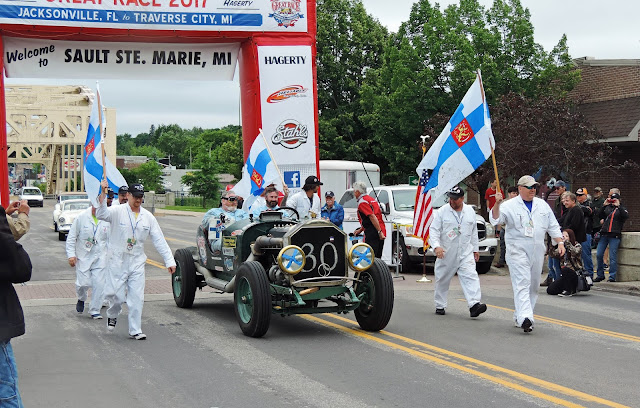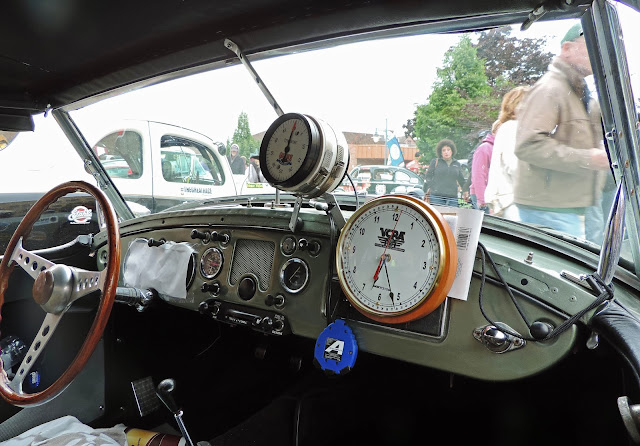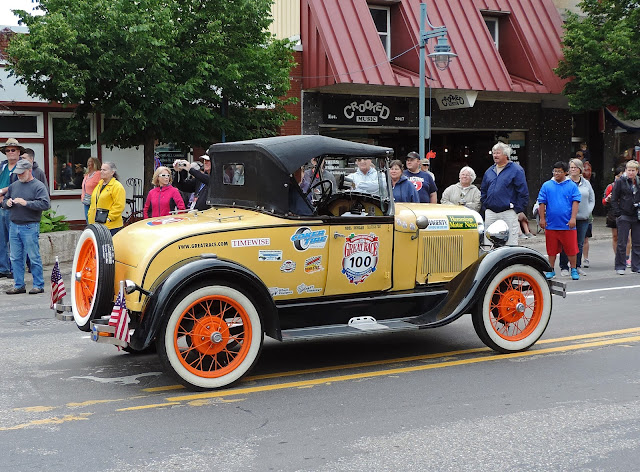Title : The Soo - Great Race
link : The Soo - Great Race
The Soo - Great Race
The Last Dance crew also enjoys vintage cars, an activity that is usually missed while cruising. The Soo also provided a chance for a bit of an old car fix. The Great Race made a stop in Sault Ste. Marie, Michigan.
The race began in Jacksonville, Florida, a block away from our oldest daughter Amanda's home. She saw the beginning of the race, we thought it would be interesting to see the northern most point. There was one more day in the race, where the participants would head back south to Traverse City, Michigan, ending in the home of one of the major sponsors, Hagerty Insurance.
Even though this event was a day after the Engineers' Day activities, and the beginning of summer celebration, you will note that a lot of people are wearing warm clothes, except for the announcer Corky Coker, in shorts. This is an event that is filmed for TV and Corky announces the finish of each day dressed the same way - shorts and a red Great Race shirt. Fine for Florida, a bit inappropriate for Upper Peninsula Michigan
First car across the line was appropriately car #1, a 1916 Hudson.
Some teams make a huge event out of the Great Race. This group, driving a 1918 American LaFrance Speedster, had a Norwegian theme, with a large traveling crew, each adopting a Norwegian name. A parade of flags accompanied the car across the finish line.
Small town Sault Ste. Marie closed down the main street of the town for the event.

Over 100 cars were in the race, representing a wide variety of manufacturers, model years, and types of cars. This is a 1937 Ford coupe race car. There were also an Edsel and a couple of Studebakers.
There was a team from Japan running a 1964 Subaru 360, named so because it is powered by a 360 cc engine. Most motorcycles are powered by larger engines. This team made the race a huge event, being followed by a car with mechanics and parts and another car with Japanese media.
British cars were represented by a couple of MGAs, an MGB, and a Jaguar XKE. A Volkswagon Beatle can be seen in the background.
How can such a wide variety of cars compete in a single race? Since it is a race over public roads, the race scoring is not base on the car which covers a distance in the shortest time, as most traditional races. Each day is comprised of a route of many segments. The route is unknown to competitors until the morning they leave. Different roads are to be traveled at a specified speed. When the competitor gets to the unknown checkpoint along the route, they are scored by the time they arrive, given a penalty point for each second they arrive early (if too fast) or late (if too slow). There is also a mathematical factor applied that gives older cars an advantage. Each car is equipped with a large clock to keep track of time and a highly accurate speedometer. They are not allowed to use an odometer in their calculations and you can see in this image the cars gauges, including the odometer, are covered. The navigator is more important to success in the Great Race than the driver.
So, even an under-powered, poorly handling 1964 Fiat Multipla van has a chance in such a race. Although, by the signage on the car, such as "Driver: This Guy," rather than a name as traditional, shows they were here for the fun and camaraderie rather than the competition. The surfboard displayed in front of the car is carried on top when they are competing, adding greatly to the aerodynamic drag. The engineers of Engineers Day would disapprove.
Much to see at the Great Race. Great way to spend an afternoon and evening enjoying a spectacular collection of vintage cars.
Thus Article The Soo - Great Race
That's an article The Soo - Great Race This time, hopefully can give benefits to all of you. well, see you in posting other articles.
You are now reading the article The Soo - Great Race with the link address http://objectours.blogspot.com/2017/08/the-soo-great-race.html
















0 Response to "The Soo - Great Race"
Post a Comment